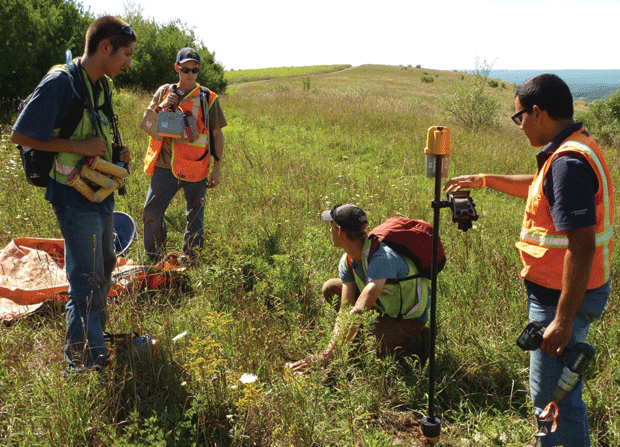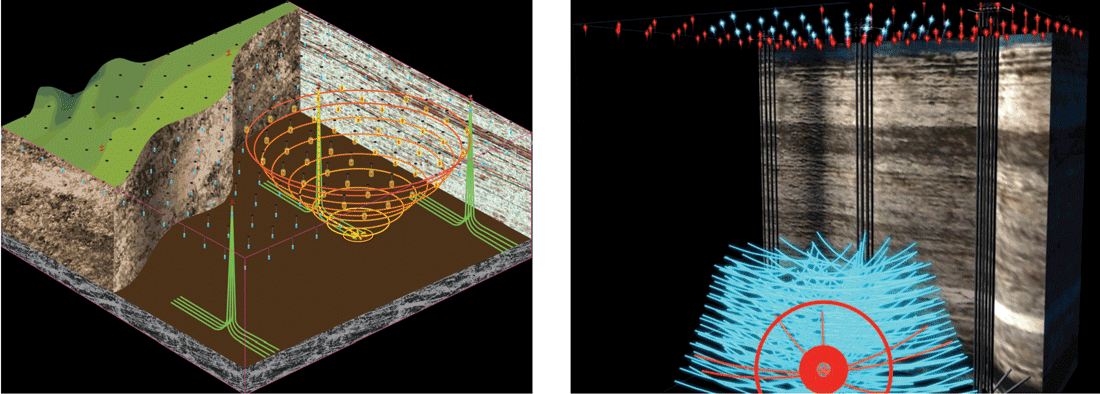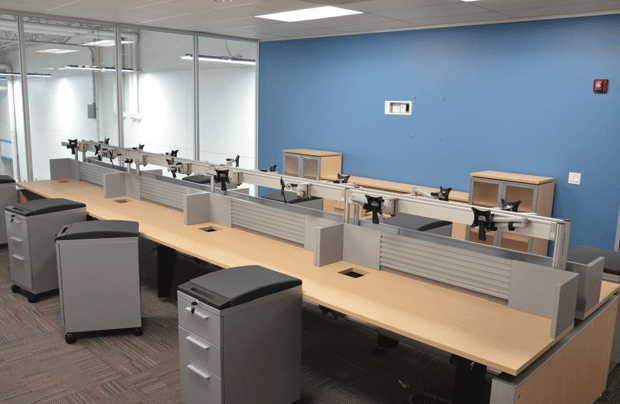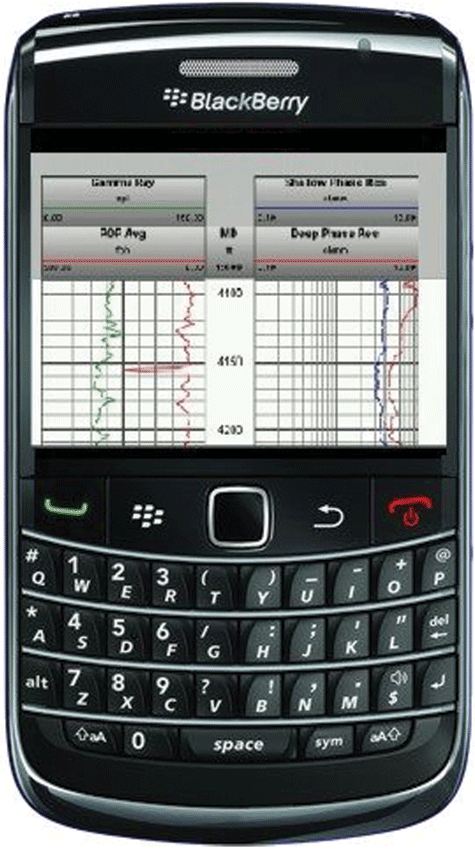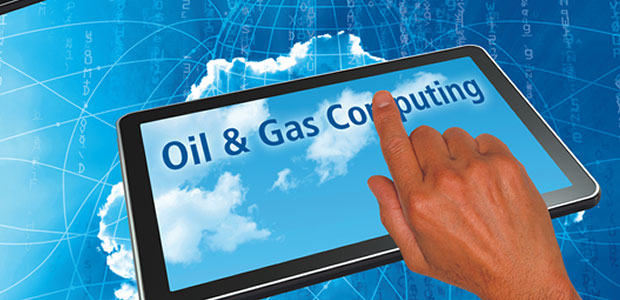
Wireless Mobile Devices Opening New Possibilities For Oil And Gas Operations
By Kari Johnson, Special Correspondent
The convergence of smart phones and tablets with new developments in cloud computing, wireless communications, data storage, middleware and software are building quickly toward a revolution in mobile computing systems in the exploration, drilling and production industry.
With oil and gas professionals already thoroughly connected to cellular wireless networks, and microchips firmly embedded in every imaginable upstream oil and gas business process, a new generation of mobile hardware and software solutions is positioned to introduce potentially game-changing possibilities that reshape workflows across corporate disciplinary domains–from executives and managers, to geologists and geophysicists, to drilling and production engineers. The goal is to provide a pervasive computing environment with almost “ambient” communications and intelligence for unobtrusive access to information at all times.
Mobile devices and cloud computing are gaining tremendous interest and deployment in consumer sectors, and technical and business users in the oil and gas industry are taking notice of the potential financial and competitive advantages related to mobile and cloud computing. The latest generations of smart phones and tablets seem to have fairly predictable form factors and a couple dominant underlying operating systems.
Cloud computing technology is more nascent, however, leaving it to the beholder to judge the difference among various incarnations. In fact, to a large degree, the cloud seems more of a user experience than a specific implementation. Even the name is not settled–software as a service, hosting, virtualization, and utility computing are only a few of interchangeable terms used to describe the concept. Clouds aimed at consumers tend to be public, although private and hybrid approaches do exist for applications requiring greater security or performance. In all cases, clouds are designed to enable self service, economies of scale, and simpler infrastructure management.
Ever-Marching Drumbeat
While mobile computing hardware and software manufacturers are envisioning a bright future, and oil and gas professionals are expecting great things to come, ION Geophysical Chief Executive Officer Bob Peebler says one should step back and consider the trajectory of information technology infrastructure.
“Underneath it all is the ever-marching drumbeat of compute power and bandwidth,” he notes. “Only 10 years ago, we were happy if hotels offered dial-up service for the Internet. Wi-Fi was brand new.”
Today, more than 95 percent of the U.S. population is connected wirelessly by cell phones, and tablet users are growing exponentially, with more than 10 billion tablets expected to access the Internet by 2015. Simultaneously, major software applications are moving away from the desktop and into the cloud. As these technologies find their way into the oil and gas business, Peebler says he believes the potential leverage is underestimated.
“The fundamental drivers continue to be compute power, storage and bandwidth. The rate of change probably will increase and so will the amount of data to process,” Peebler remarks. “In the oil and gas industry, we are acquiring more data and making more physical measurements than ever before, and then interpreting and simulating models built from those data.
“Yet at the same time that we are collecting, analyzing and interpreting more and more data, we are miniaturizing our computing devices,” he goes on. “The technology platforms from the last 20 years are not ready for this data explosion.”
Cloud computing promises a big discontinuity, Peebler holds. “This model offers rapid deployment, service elasticity, staff efficiency and IT optimization. The iPad® provides a window into the world of cloud computing. Most of the power of that device is actually out there somewhere. Video and social media are all cloud computing.”
The challenge Peebler sees for the oil and gas industry relates mainly to the physical data. “Companies first have to get through the security issue and the fear in externalizing the data,” he relates.
Consequently, Peebler says he expects early implementations to start inside the firewall as private clouds that may expand to external resources when needed and where appropriate. Bandwidth remains another concern, given the huge volume of data common in the industry. “Practical issues will control the rate of diffusion,” Peebler states. “However, in 10 years, personal computers as we know them will be gone, and we will be working with servers in the sky.”
The implementation will take different forms for different disciplines, he suggests. For example, in seismic acquisition, mobile devices already are being leveraged for crew connectivity and quality control, and future possibilities are boundless–perhaps including large amounts of data processed onboard in marine surveys during acquisition. “If the cloud works right, it will feel and act local no matter where the data and software reside.”
Considering the remarkable progress that has been made since the days when Bill Gates predicted a PC on every desktop, Peebler says it is impossible to foresee exactly what forms and functions mobile computing ultimately will take in oil and gas.
“After all, who in the camera business forecasted a decade ago that their biggest competitor would be mobile phones?” Peebler posits. “There will be a wave of new applications and new ways of doing things that could be a sea change for the industry. It requires a mind shift. A lot of the challenge will be in figuring out how to take advantage of it.”
Form And Function
How mobile devices will participate in data analysis and decision support is very much subject to debate. From a communications perspective, they are invaluable and their ubiquity is changing the way people interact with applications, notes Jean Claude Dulac, chief technology officer at Paradigm.
Even while the oil and gas industry is collecting, processing and analyzing more and more data, the computing devices used to visualize and interpret those data are becoming miniaturized and increasingly mobile. Although it is impossible to foresee exactly what forms and functions mobile computing ultimately will take in exploration, drilling and production workflows, mobile devices already are being leveraged in areas such as seismic acquisition to ensure crew connectivity and quality control. Shown here is a seismic crew deploying wireless recording stations in the Marcellus Shale.
“The form factor is very limiting for traditional interpretation and analysis applications,” he says. “Application developers must focus on the clear value these devices can deliver, such as real-time data monitoring, quality review and decision making support. Imagine post-work review and validation performed by virtual teams spread across the globe and working on a variety of platforms, including tablets and even smart phones connected through video conferencing.”
This type of distributed collaboration overcomes one of the biggest challenges to the centralized visualization center, where a team of cross-disciplinary experts are brought together in a single room, points out Philip Neri, Paradigm’s vice president of marketing. “To get that many decision makers into the room takes significant scheduling coordination,” says Neri. “In contrast, a mobile meeting could present the same information to the same group of people on almost an ad hoc basis, while also supporting live interaction with the data set and the presentation of multiple scenarios.”
For Dulac, selecting the right applications for various form factors is paramount. “At a well site, a mobile device might be perfect for monitoring the data streaming out of the well during drilling,” he says. “I could definitely see some smart phone- or tablet-based applications that provide a quick look at data or enable certain quality checks.”
At the same time, however, Dulac says workstations will still very much continue to be at the center of analysts’ daily workflows, leveraging parallelization and CPUs for increased power. “Mobile devices will not replace the workstations, but enhance the computing and connectivity of the analysts,” he states, speculating that laptops, on the other hand, could well get squeezed out by tablets.
A complicating factor for mobile device application developers is the many operating systems in use. One approach to cross-platform functionality that Paradigm has been taking is to design select applications to run in browsers, according to Dulac. Tools to query and simultaneously browse cross-project and multiple data repositories are ideally suited for Web enablement with popular Web-based languages (e.g., Java), and he says the company is interested in HTML5 (a new generation of Hypertext Markup Language now under development) as the new standard for Web application development.
One of the practical challenges to using mobile devices in geophysical applications is simply transitioning to a small display screen. Rather than replacing workstations with large visualization displays, small-screen mobile devices will be ancillary to them–especially for large and complex data volumes, such as these projections from a microseismic project using buried geophone arrays.
“While browsers have their downsides, such as the screen real estate they consume, browser-based HTML implementations are more economical for an environment that is changing at light speed,” Dulac says.
Leveling The Field
Another promising way to level the playing field among computing devices is to leverage a cloud configuration, argues Dulac. Accordingly, Paradigm has designed its software architecture to be cloud-compliant and functionality can be segregated to support various use cases. “Our database management, for example, allows heterogeneity in platform and geography,” says Dulac. “This offers enormous flexibility for companies that want to transition to the cloud over time.”
In a well-designed cloud implementation, the bulk of the work could be done at the cloud and displayed on the device. While there is some understandable reluctance within the industry to venture into the cloud, Neri says he believes this will be short-lived.
“One day, someone is going to wake up to the compelling economic case for the cloud,” says Neri. “The day the chief financial officer of a large producing company stands in front of the board and makes the case, you could very quickly see a massive sea change. These are not small numbers. Clouds can halve the cost. If concerns about data security are finally set aside, we could see a stampede toward cloud solutions at any time in the oil and gas business.”
Of course, a cloud computing configuration requires continuous wireless connectivity to data and applications, which can be a problem in remote areas where industry professionals often work, adds Dulac, noting that wireless networks–no matter how sparse–can be the only option for operations in countries without significant land line infrastructures. “For users with intermittent or unreliable communications, applications would have to have a local element for continued work and a method for synchronizing when reconnected,” he comments. “Clearly, this functionality is critical to defining the right implementation for customers.”
For Paradigm, the key to developing future cloud and mobile computing platform strategies is listening to the market, Neri concludes. “The customer has to be at the center of any application strategies, including the platforms and form factors we support,” he says. “The value that we bring is in the science and intelligence of applications, but the needs have to be defined by the marketplace.”
Staying Connected
One of the key drivers behind adopting mobile devices in the oil and gas industry is the need to stay connected to data and decision makers. That always has been a challenge in the oil patch, given the huge volumes of data, often remote operations, and time spent traveling to and from locations, points out Mike Mueller, vice president of analysis at MicroSeismic Inc.
“In the old days, we operated at a slower pace because the ability to react quickly was limited,” Mueller reflects. “With advances in real-time technology and mobile computing, there is a greater ability to not only respond faster, but to impact the outcome through more informed decision making. Mobile devices have become a critical driver of efficiency, allowing us remote access to information necessary to get the job done right.”
During surface and near-surface microseismic acquisition, there is a need to know precisely where and when one is at all times, which is a feature built into smart phones and tablets with global positioning systems, comments Mueller. The time and positioning elements within both 2-D and 3-D space are fundamental to accurate geophysical studies.
But at the same time, there are practical aspects that serve to limit the applicability of mobile devices in the geophysical domain. “One of the big challenges in geophysics is simply transitioning to a smaller screen,” Mueller says. “Because of the volume and complexity of data sets, we are accustomed to working with giant visualization displays and dual monitors, and routinely cover walls and tables with printouts. Small-screen mobile devices will not replace workstations, but be ancillary to them.”
Nevertheless, he says, there is a great opportunity to review survey results in real time on mobile devices so that decisions can be made immediately. He cites one example from his own experience. “I was in China meeting with executives of an oil company to discuss the value microseismic surveying could provide. During a break in the meeting, I received an image on my Blackberry™, generated in real-time from a microseismic project in the Eagle Ford in South Texas. When I shared it with one of the executives, he became an instant believer.”
To study user interactions and ergonomics with mobile devices, Baker Hughes is constructing a “usability laboratory” with an observation room, surveillance cameras, software and hardware, eye-tracking tools, and even a cognitive psychologist on hand. It is also building an “innovation lab” to investigate a variety of advanced interaction styles, including gestures and 3-D, as well as two mobile “think tanks” equipped with projection systems and walls that can be drawn on.
In a sense, the entire seismic acquisition market has been trending toward wireless technology for several years, Mueller notes, with wired sensors and storage devices being re-engineered into cableless battery-operated devices. “We used to have tons of cable strung all over the place to connect geophones,” he remarks. “We needed large trucks and other heavy equipment. Now the geophones have a smart phone-like system that knows where it is, communicates with the control system and records data continuously.”
MicroSeismic uses a grid-based system with two to four stations every square mile to collect active and passive seismic data. The geophones are buried 100-300 feet below the surface with a wireless device at the surface to collect and transmit data. The company’s largest buried permanent microseismic array installation covers 152 square miles, according to Mueller.
He says, “These are typically passive listening devices that record events that occur during fracturing jobs or during production. The geophones detect microseismic activity, which can be interpreted in terms of pressure changes, fluid changes and sweeping fronts of liquids. There is no need to drill observation wells, because the geophones are emplaced permanently to ensure that recordings are perfectly repeatable for time-lapse 4-D monitoring.”
Seeing Around The Bend
In a special workspace at Baker Hughes in Houston, Joel Tarver, manager user interface and user experience, and his team are carefully studying the rollouts of new commercial devices, form factors and operating environments as they develop a mobility strategy for Baker Hughes. “To be most successful, we need to see around the bend to anticipate what is coming so that our internal tools and customer products are appropriate when they are released, and not just when they are conceived,” says Tarver.
The industry’s goals with mobile devices is to improve ease of use and economies of scale. One of the keys to successfully implementing a mobile computing initiative is to rethink and reinvent workflows for mobile devices. Rather than simply representing a new form factor, mobile devices are used in fundamentally different ways than desktops or laptops, with users tending to use mobile devices 20-30 times a day for about five minutes at a time, and laptops in much fewer sessions a day but for considerably longer times.
He notes that the high consumer adoption level of mobile devices is driving higher expectations within the business community. “Multitouch is now a well understood interaction style, thanks to iPhones™, iPods™ and iPads™,” Tarver observes. “We must figure out how to incorporate that in a meaningful way within the oil and gas industry.”
Tarver says he sees plenty of conceivable applications for touch screen tablet technology and even phone form factors. Equipment and production monitoring, data review and data collection in hazardous environments are a few examples, but they also can play a role in reviewing, annotating and interacting well logs and other data, he suggests. “It is not a simple matter of porting applications between platforms,” Tarver says. “New form factors and new interaction styles demand new ways of thinking about how to best execute familiar tasks.”
Touch screen technology, for example, did not experience immediate success, because it took time for the manufacturers of devices to understand and leverage its full potential. Only when applications were reconsidered and with the emergence of multitouch interaction did it become transformative, Tarver says.
“The real challenge is to conceptualize again and recreate based on how users want to work,” he offers. “An example of this is the concept of having the user’s eyes serve as a tablet’s navigation tool in a hazardous environment instead of a touch screen. That is the kind of reinvention needed.”
Tarver says he expects a movement away from the “Swiss army knife” approach, where an enormous breadth of functionality is contained within a single application. Instead, he sees applications broken into tasks, some of which may become stand-alone desktop tools, while others will be deployed as mobile phone and tablet applications. “We need to realize what is most important for the user to do on different platforms, and how the various technologies can enable new workflow designs based on the user’s needs.”
While engineers typically are concerned with functionality, Tarver says his focus is on usability. To this end, Baker Hughes is launching a “usability lab” with an observation room, surveillance cameras, software and hardware, eye-tracking tools, and even a cognitive psychologist on hand. The company also is creating an “innovation lab” where a variety of advanced interaction styles will be investigated, including gestures (with technology such as Microsoft Kinect™) and 3-D. Finally, he reports that there are plans for two mobile “think tanks” equipped with projection systems and walls that can be drawn on.
One of the projects Tarver’s team is working on is optimizing the control systems on the rig floor using a hardened device from a partner company. “We go onto the rig with the device as it is installed, angled and used so that user interaction ergonomics can be better understood,” Tarver concludes. “We want to know how technology can be used to make workers safer, more productive and better connected to information.”
Great Business Value
As the IT executive in charge of both architecture and infrastructure operations at Baker Hughes, Jim Heaton has a big impact on technologies used within the company, as well as those delivered to customers. He says he sees a major role for mobile devices for data referencing and decision making. He also says he expects to see high-resolution, high-performance applications engineered for these devices. “Users will be able to see the latest data delivered as a sliver to the smaller form factor,” says Heaton.
He also says he sees enormous value in using devices to control everything from desktop applications to high-performance computing clusters. “The ability to monitor, adjust and restart massive compute jobs has great business value,” notes Heaton. “It is a perfect application for mobile devices used by an extremely mobile workforce.”
In fact, Heaton says he can imagine using a smart phone to kick off a high-performance computing job, receive regular updates, generate images, and post them into presentations on the fly. “Applications will have to be compatible with that kind of interaction,” he holds.
One of the underpinnings of Heaton’s vision is a shared perspective about applications becoming smaller in their functional scope. Baker Hughes is re-evaluating its approach to delivering functionality and moving to this model of smaller deliverables, he relates. Instead of simply resizing an application for various devices, this approach calls for creating applets or “nuggets” that can function as an independent element on a tablet, or together with others as a large mosaic in a large-screen computing environment.
Heaton says he foresees this approach as leading to a new generation of user interfaces for commercial applications, where the functionality is consumable on a variety of screen sizes. Smaller form factors might have layers of transactional screens, whereas larger form factors would allow the users to switch context rapidly, he explains.
“There is potential for a paradigm shift for geology and geophysical applications,” Heaton says. “Applications can start to change, compartmentalize and become more efficient on all computing platforms.”
Coincident with the desire to use various form factors is the ability to accelerate computing through parallelization. Baker Hughes has collaborated with Microsoft Corporation on a massive parallelization project that ran in multiple environments, including high-performance computing, SAP servers and scientific computers in Azure™, Microsoft’s cloud environment. Heaton notes that the horizontal computing project demonstrated the merits of accessing and leveraging massive computing resources by taking advantage of idle computing power, reducing the time it took to crunch the numbers from weeks to hours.
Designing for a horizontal computing architecture will result in applications that will survive for years, regardless of changes in the specific computing systems available, Heaton contends. “Unlike vertical computing, where compute power is concentrated in each CPU and one piece of code runs extremely fast, horizontal computing ties together lots of smaller CPUs that run numerous small ‘nuggets’ independently,” he states, pointing out that an ongoing example of this environment is the SETI project.
With this project, individuals around the world can allow their computers to be used by the project when idle to participate in the search for extraterrestrial life.
Cell Phone ‘Network’
Done correctly, companies can write code that runs faster and faster on massively cheaper machines, according to Heaton. In fact, there is no reason that the same horizontal computing architecture that runs with idled desktops and laptops cannot be used to run complex computations on large groups of networked cell phones or tablets.
“We are kicking around the idea of linking all the company’s cell phones as a massive horizontal computing environment and running some application on it to see how it performs,” Heaton relates. “Mobile devices are gaining computer power and likely will be doing high-end computing someday. Some of the newest devices already have dual cores and more are coming.”
Massive computing and storage resources available by connecting a network of CPUs–whether the cloud is private and internal within a company’s firewall, or public and distributed externally across the globe–offer great promise for both simplicity and cost savings, according to Heaton.
The private cloud, where data and computing resources are controlled by the company, is a good first step for companies looking to leverage computing resources, if they are wary of security concerns, Heaton advises. He suggests companies design for the public cloud, but run clouds privately to retain control. “Supporting a plethora of small devices will drive companies into a more centralized cloud infrastructure,” he adds.
Like other companies engaged in the oil and gas business, mobile computing is becoming ubiquitous within Baker Hughes, and IT is defining support strategies for the numerous platforms. “Some devices and operating systems are strategic and we invest in supporting them natively,” Heaton says. “We support others through virtualization.”
There are still a wide variety of platforms to support in some fashion, but Heaton says he sees promise in the HTML5 standard, which could become the new JavaScript within a few years. The hope is that it will enable better synchronization for tablets and take advantage of local screen and computer power.
“Senior executives as well as junior employees are bringing high-end mobile devices into regular workplace use,” Heaton observes. “They are driving developers to rethink how applications should run, what they should do on the screen, and how users will interact with data. We find that most mobile devices are fairly well cared for, and because we regularly synchronize data, there is not much risk of data loss from a damaged device.”
Infinite Possibilities
Nagaraj Srinivasan, vice president of research and development at Halliburton, says the company’s technology developers are excited about the possibilities of mobile and cloud computing, and are looking at how to make operations much more intuitive and visualizations much richer.
“We believe that the demand for mobile applications is huge and that there are almost infinite possibilities in oil and gas operations,” says Srinivasan. “However, our focus is on the mobile workforce such as the person at the rig, who has to interpret data and submit it for approval in an environment where every minute counts.”
Halliburton is prototyping several hundred devices within the company, with the combined goals of improving ease of use and economies of scale. “The wide range of device types and operating systems poses a challenge for the development environment,” Srinivasan says. “However, I believe HTML5 will fundamentally change the way applications are developed and deployed. We will be able to build once and deploy to that range of devices without significant effort.”
Srinivasan cites three key drivers impacting computer selection in the oil and gas industry. First, connectivity remains a concern given remote work locations, so applications cannot be entirely dependent on a continuous connection. Second, the volume of data acquired, processed, transmitted and interpreted continues to rise, with more sensors down hole, increased seismic data acquisition, more live data streaming in from rigs and production sites, and higher resolution for just about all types of data. Third is the general desire to tap into the data stream in real time to visualize and evaluate data, and make operational adjustments on the fly.
“For best success, we need to rethink what we did on the laptop and desktop and reinvent for mobile devices,” Srinivasan offers. “These devices are not simply a different form factor. They are used in a fundamentally different way. In general, users tend to use laptops in six sessions a day for about an hour each time. On the other hand, they use mobile devices 20-30 times a day for only about five minutes at a time.”
The concept of collaboration is changing as well, and Srinivasan says he expects mobile computing to make two forms of collaboration common. The first is collaboration through data, where multiple people look at the same data set, work on the data individually, and then share their results. The data are expressed as discrete packages that are integrated in a central manner. The second is cross-domain workflows that allow users to interact with the data in real-time simultaneously.
“This new generation of mobile applications has the chance to dramatically shorten the time required to make a decision while also helping improve the quality of that decision,” Srinivasan remarks.
He says immediate applications for mobile devices include time entry, alerts and access to dashboards and metrics, but Srinivasan suggests that the biggest benefits will be in improving efficiencies and reducing costs. “We expect mobile devices to eventually have a very positive effect on costs by reducing the requirement to travel to the rig or production site to monitor equipment, reducing labor costs as well as the environmental impact,” he concludes. “At the same time, mobile devices will increase collaboration and improve decision making.”
Real-Time Computing
In drilling and production operations, real-time information and data management are a growing necessity. Traditionally, the collected data are sent to a centralized location for analysis, but it is now practical to deliver data in real time directly to mobile devices, reports Tessy Phillips, Halliburton’s director of real-time solutions. “The ability to monitor drilling and production processes and get the data on portable devices in real time definitely resonates with our customers,” says Phillips.
Halliburton’s vision is to get information in real time wherever it is needed. The challenge is to present the data in a meaningful way when screen real estate is limited. “We have done some investigations into sending measurement-while-drilling and well log data to mobile devices, but have found that the value is in delivering actionable results to the decision maker,” Phillips says. “The challenge is to develop techniques to amalgamate and present results appropriate to mobile devices.”
Today, data are delivered to dashboards that signal an alert when data are above or below predefined limits, but Phillips says the cloud is an enabler to take this capability to a new level. “The entire world is learning about what can be delivered to mobile devices from cloud configurations,” she comments. “Designers of hardware and graphical user interfaces still are learning what can be done and what interactions make sense for the user.”
The other big issue, of course, is security, adds Phillips. “Everyone is wrestling with how to secure data on so many mobile devices, especially given the value of that data in the oil and gas industry,” she says. “Add to that the idea of pushing data around in a cloud and there is even greater concern. Companies are giving careful consideration to what should be presented on a mobile device.”
Phillips agrees that the first iterations of cloud computing for most oil and gas companies will be private environments, followed by migration to a public cloud model. “I see cloud computing becoming another utility,” she remarks. “In 10 years, it will be a utilitarian computation resource, just like water and electricity are shared resources that are tapped as needed. Cloud computing provides tremendous economic benefits, and most users will become comfortable with using it in time.”
A move toward thin applications may be next, says Phillips, citing the Kindle Fire™ as a step in that direction in the media content arena. The Fire device relies on the cloud for data storage and much of its computing resources. “Without a doubt, customers are all asking how to reduce local data and computing resources as much as possible, with zero being ideal,” Phillips concludes.
For other great articles about exploration, drilling, completions and production, subscribe to The American Oil & Gas Reporter and bookmark www.aogr.com.














